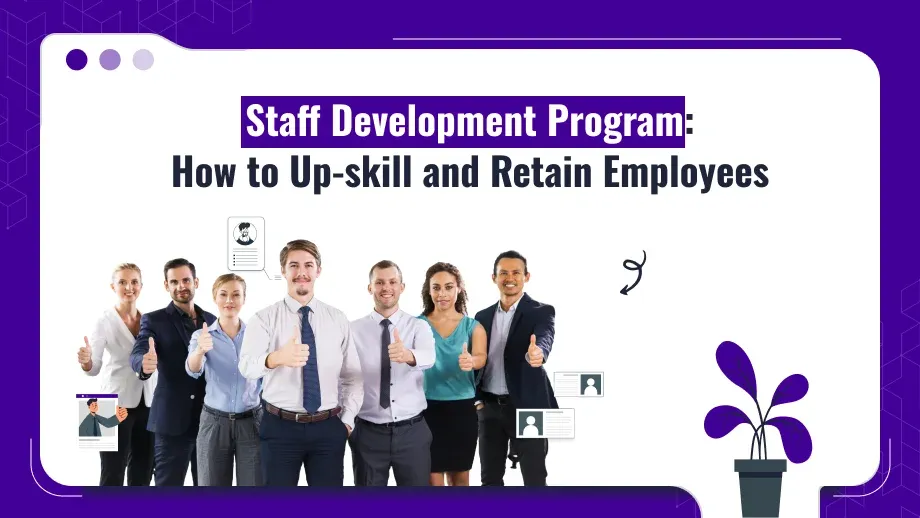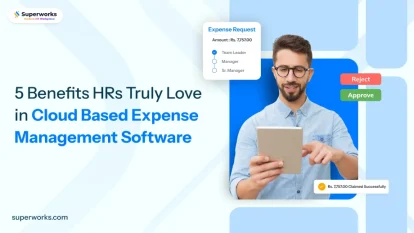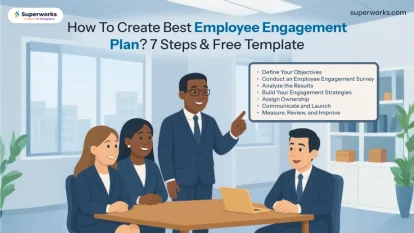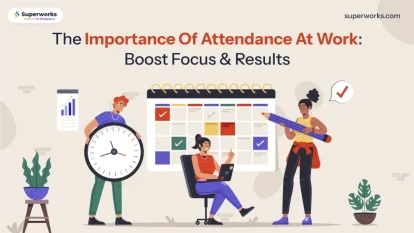
Why a Staff Development Program
A staff development program is a planned approach to develop employees’ skills, knowledge, and overall professional abilities. A successful staffing development program does more than just improve the skills of employees, but also improves the efficiency of employees and increases engagement. This results in greater retention rates.
Having a clear staff development process is key to being a competitive and sustainable organization. A solid plan for staff development will address skills gaps, create the potential of employees, and connect their growth to the business’s goals. It’s not only about individual development it also aids in broader organizational development and HR growth within the business.
In this article we’ll look at the different types of staff development programs, how to develop a training plan and the strategies to grow and retain employees.
Retention Through Staff Development Programs
One of the benefits that is often ignored by a well-designed staff development program is the impact it has on retention. The employees of an organization are likely stay with an employer which invests in their development and provides a clear pathway for growth. Here are some strategies to link the development of employees to retention goals:
Career Pathing and Growth Opportunities
The ability to establish a clear career advancement structure is essential to keep the best talent. Employees need to see how their work contributes to their growth. A planned staff development program plan specifies the particular skills needed and goals for promotion.
- Career Pathing Tools: Software that maps out potential career paths within the company.
- The Leadership Development Programme: Helping to prepare employees to fill managerial roles.
- Role Rotation allows: employees to try different roles and build the skills needed to be a multi-tasker.
Recognition and Rewards
Linking development programs to performance incentives and recognition will drive engagement and retention. Companies can set up mechanisms to reward employees who have completed training courses, develop new skills, or show potential as a leader.
- Employee of the Month Programs: Recognising achievements linked to development.
- Bonuses for Training Completion: Rewards in the form of financial rewards for employees who have completed advanced training.
- Skills Certifications: Certificates or badges that demonstrate new skills.
Continuous Learning Culture
An environment where continual learning is encouraged is essential to a well-functioning timestaff attendance management system. This is about promoting the notion of learning as a continuous process as well as integrating education into your daily work.
- The Lunch and Learn Program: A few minutes of short informal sessions of learning in lunch break.
- The Internal Learning Platform: Designing an organization-specific platform for sharing information.
- Recognizing Knowledge Sharing: Honoring employees who are part of the culture of learning.
Ownership Through Engagement
Participants in the planning of their training plans experience an ownership of their progress. This leads to higher commitment and lower turnover. Companies can:
- Self-Directed Learning Programs: Employees choose their own learning paths.
- Feedback Loops: Regular employee input into employee development programs.
- Development Committees: Groups of employees who determine the development plans.
Revolutionize HR Processes – Explore a Complete HRMS Solution!
Empower your payroll processes, streamline operations, and boost productivity! Take the first step towards a more efficient payroll future with Superworks!
Measuring Staff Development Programs
To assess the effectiveness of a personnel program, you must determine the effectiveness of the program using specific KPIs and metrics. Organizations can monitor their employee improvement initiatives through:
Measurable Goals
The first step is to establish specific, quantifiable goals that are in line with the organization’s goals overall. This implies that the development of the staff development process directly influences the business’s growth.
- Skills Improve Metrics: Percentage of increase in skills of employees.
- Engagement and Participation Rates: How many employees are participating in compliance training for Employees and other training programs?
- The Performance of Projects: What staff development program affects project outcomes as well as business performance KPIs.
Key Performance Indicators (KPIs)
KPIs help measure the effectiveness of a staff development program. Some KPIs:
- Employee Satisfaction Scores: Using surveys to measure satisfaction with development initiatives.
- Retention Rates: Tracking whether development programs are reducing turnover.
- Productivity Metrics: Measuring if skill enhancements are translating to higher productivity.
Collecting Feedback and Making Iterations
Feedback from the participants regularly is crucial to improve the development of staff. Organizations must have a process to collect input from employees and implement changes.
- Collecting feedback immediately after each session, including employee evaluation feedback, to assess the effectiveness of the training..
- 360-Degree Feedback: Involving peers, subordinates and managers in the evaluation.
- Focus Groups: Holding group discussions to get detailed feedback.
Types of Staff Development
In order to create a successful employee development program, it is essential to know the various kinds of programs available and identify which are compatible with the needs of your company. Each plan for training development can have a distinct objective, be it the development of leadership skills, skill improvement, or technical education. Below are the principal kinds of staff development programs:
On-the-Job Training
On-the-job training is among the most popular kinds of employee development. Learning by doing is a process of learning which allows employees to acquire new abilities through practical experience within their work environments. This form of training for employees can be particularly beneficial for jobs that require technical knowledge or a specific level of software expertise.
- Job Shadowing: allows employees to look at their peers who have been successful to gain an understanding of how they perform their jobs.
- Task Rotation: The employees get rotated between different jobs or divisions to increase their skills.
- Work-based learning: Students are assigned specific tasks that test their current abilities and promote their growth.
Mentorship and Coaching Programs
The mentorship program pairs less experienced employees with Staff development program members of higher experience to help them navigate their professional development. It’s a good method to promote knowledge transfer and the development of leadership. It may be informal (peer-to-peer coaching) or more formal (formalized coaching programs).
- One-on-One Mentorship: Regular sessions between a mentor and student mentee for discussion of career objectives and growth plan.
- Leadership Coaching: focuses on creating high-potential leaders for roles.
- Group Mentorship Sessions: In which the mentor collaborates with employees to provide insights and expert guidance.
Mentorship programs are implemented to help employees develop their leadership skills. can be tied to the attainment of the HR development goals by establishing an internal pipeline for leaders.
Workshops and Seminars
Workshops and seminars are brief programs for employee development programs that focus on specific skills or subjects. These can be conducted internally or assisted by experts from outside which are great for learning abilities like collaboration, communication and problem-solving.
- Technical Workshops: To improve your skills in particular areas such as engineering, software, or project management.
- Training in Soft Skills: Covering topics including the art of public speaking, negotiations, and interpersonal abilities.
- Innovation Workshops: Creating a sense of imagination and generating innovative ideas for new products or services.
Workshops and seminars are adaptable and can be included in the larger training development plan that takes into account the needs of the present and future of the business.
E-learning and Online Training
Thanks to the rapid growth of digital learning platforms, online education is now a key element for modern employee advancement. It provides flexibility, scalability, and an array of content that employees can get on demand. This method is particularly useful for remote or distributed teams.
- Micro-Learning Modules: Minimal targeted training sessions workers can finish in 10 to 15 minutes.
- Interactive courses: Grab your attention with engaging and engaging content that includes quizzes, games as well as case studies to enhance learning.
- Certification Programs: Structured courses that lead to professional certifications.
Learning can be efficiently managed with the help of cloud-based HRMS software, that tracks the progress of employees as well as learning results.
Leadership Development Programs
A focused approach to developing the next generation of leaders, leadership development programs are critical to building a strong leadership pipeline. These programs focus on strategic thinking, decision-making and people management skills.
- Executive Coaching: Customized programmes to help you develop top-quality management skills.
- Succession Planning: preparing middle-level managers for the transition into more senior positions.
- Leadership Bootcamps: These are intense classes that mix classroom education with simulations, real-world scenarios, and classroom learning.
Making investments in the development of leaders ensures a workforce that is future-proof and helps with the development of organizations.
Challenges in Staff Development Programs and Solutions
A staff development plan provides many benefits however, it is not without its challenges which organizations have to face in the implementation. Here’s how to overcome them:
Budget and Resource Constraints
One of the major obstacles to implementing an effective personnel development plan is the budgetary constraints. Employee development programs that are comprehensive need investment in training tools and technologies, as well as external trainers. To overcome this:
- Concentrate on areas with high impact: Start with projects that offer the greatest ROI for you, like the development of your leadership or upskilling in technical areas.
- Make use of internal resources: Utilize Internal subject matter experts from within to conduct training sessions instead of hiring consultants from outside.
- Using E-Learning Solutions to Improve Learning Digital platforms may cut costs significantly while preserving high quality.
Employee Resistance to Change
Some employees may be resistant to any new development programs for their training because of insecurity or anxiety about the increased workload. To address this:
- Communicate the Benefits: Clearly explain how the staff development program will benefit them in terms of career growth and skill enhancement.
- Participate in the planning process of employees To involve employees in the design of the program for development, giving employees a sense of ownership.
- Provide flexible learning options Employees can select learning styles and times that are compatible with their schedules and work/life balance.
Lack of Managerial Buy-In
To allow a process of staff development program to succeed the process requires support from the management. In the absence of this, finding the resources needed and ensuring employee engagement could be a challenge.
- It is important to align Development Goals with Business Objectives Highlight how employee human resource development assists in meeting key goals of the business.
- Share Success Stories that have been highlighted: Discuss the case studies of training initiatives for staff within your organization.
- Create a Supportive Learning Environment: Encourage managers to participate in the programs themselves, setting a positive example for their teams.
Implementing a Staff Development Program: Best Practices
Implementing a successful staff program requires strategic planning and effective execution. Here are some top techniques to think about:
- Set Clear Objectives and KPIs Define what success looks like for your training development plan. If it’s increasing efficiency, increasing satisfaction of employees, or reducing turnover clearly defined goals make sure that the strategy stays focused and productive.
- Create a Tailored Training Plan Every employee has unique strengths and areas for improvement. Develop individualised training plans that cater to their specific needs and career aspirations. This strategy increases employee participation and maximizes the return on investment of your employee development processes.
- Leverage Technology and HRMS Company Employ cloud-based HRMS applications to oversee employee development plans. Technology can help track progress, manage schedules and even offer virtual training sessions for remote employees.
- Develop a culture of learning the development of a culture that is continuous and acknowledged. Make sure you regularly update your employee program with the most current techniques and trends in the industry to ensure that employees are in the forefront of technology.
- Monitor and measure continuously the impact of your employee training initiatives using KPIs such as the improvement of skills, employee engagement levels, and retention levels. Utilize these lessons to improve and optimize your plans as time passes.
Conclusion: The Future of Staff Development Programs
The future of development for staff development program plans will be shaped by the advancements in technology, evolving expectations for employees, and the changing business environment. While organizations continue to recognize the crucial role that employee development plays in meeting the goals of HR development They must be agile and engaged.







